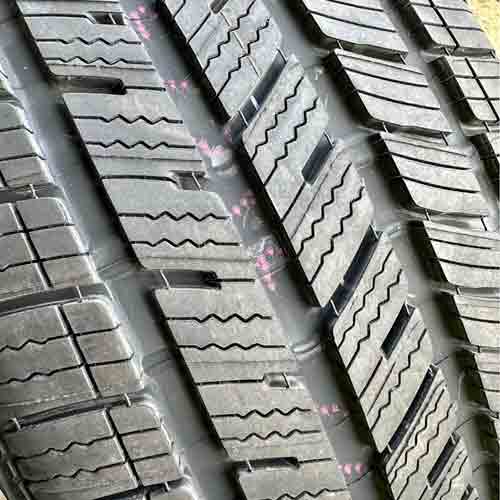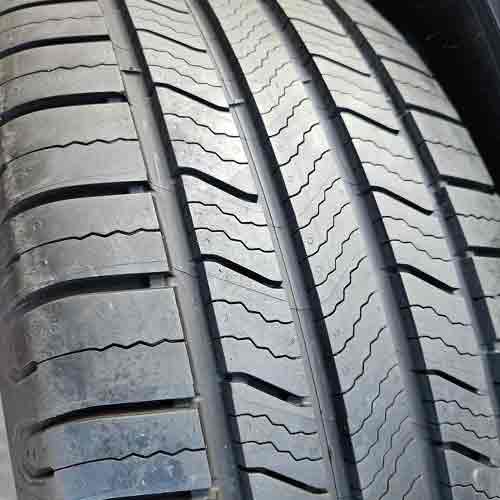Out of both tires, the Bridgestone DriveGuard Plus coming in the category of grand touring, while the Michelin Defender 2, in standard touring all-season tires, showed me some very distinct characteristics. Let’s dig in.

So, let me start off by saying: In comparing both these boys, the Defender 2 offers shorter braking distances, enhanced cornering stability, remarkable tread life, and improved fuel efficiency due to its various design features, and technologies (will talk on them later, with details). The DriveGuard Plus, though, offers superior wet traction, slightly better snow performance, and a greater comfort, (particularly at higher speeds).
Table of Contents
Construction Comparison
The Bridgestone DriveGuard Plus although comes with a similar 5 rib structure, it has an asymmetrical tread pattern.

First off, this tire is more voided up, and doesn’t carry as many sipes, as seen on its counterpart.
Though it does offer a better mixture of linear and interlocking siping on both internal and outer ribs.
The 3 internal ribs, also carry in-groove notches, and have foundational supports, where they are all sitting on a secondary continuous running rubber underneath.
While moving towards outer ribs, you see shoulders which are different from each other.
Here one side displays rectilinear siping, interconnected by thick longitudinal slits.
While other side has lugs although with similar slits, but here attached to them are wave-like siping.
Internally the tire comes with two-ply polyester casing, with 2 steel belts and a nylon cap ply. Moreover its sidewalls have extra rigid construction, allowing for its run flat design.
The Michelin Defender 2 on the other side, also features a symmetric pattern, though its more streamlined.

I mean if you compare its shoulder lugs with its competitor, you’d note how minimal they are.
See how they are only composed of lateral grooves, and a mere interlocking siping structure.
This is unlike the central 3 ribs (which form 4 longitudinal channels).
I mean they are more saturated with (similar) siping.
Here the central most rib is continuous running, while the adjacent ribs although have wave-like lateral voids, they are still not as spaced apart, if you compare them with the Endeavor.
Internally, the tire features only a single ply polyester casing with 2 steel belts, and a single ply nylon cap ply.
Diverse Sizing and Specs
Both tires come with a lot of varying sizes and specs, let’s check them out in a tabular form.
| Features | Michelin Defender 2 | Bridgestone DriveGuard Plus |
|---|---|---|
| Rim Size (inches) | 16 to 20 | 16 to 19 |
| Speed Ratings | H (all sizes) | H, V, W |
| Load Ratings | SL, XL | SL, XL |
| Tread Depth (32″) | 10.5 (all sizes) | 9 (all sizes) |
| Weight Range (lbs) | 25 to 32 | 23 to 44 |
| Winter Ratings | M+S (no 3PMSFR) | N/A |
| Tread Warranty | 85k miles | 65k miles |
| UTQG Rating | 800 A A | 640 A A |
Fuel Consumption
Fuel efficiency is heavily influenced by tire rolling resistance, which in turn is determined by three main factors:
- Tire’s weight.
- Tread’s rubber composition.
- Tread pattern/design.
Now out of both tires, the Michelin Defender 2 clearly stands out, offering superior miles per gallon (MPG). And this isn’t surprising, given that it’s categorized as a standard touring all-season tire (unlike its grand touring counterpart).
So what makes this tire better, well, its the same stuff I discussed in the tread life section.
The tire is lighter, and comes with MaxTouch tech. So there’s less rolling resistance generated.
All these elements reduce stress on the lugs.
And in contrast, the DriveGuard, with its run-flat design, has multiple layers on its sidewalls, exerting greater pressure on the lugs as they flex against the ground.
This lug flexing means more fuel energy is expended in reshaping the tread (and converting energy to heat), compromising fuel efficiency.
Highway Performance
Both tires showcase outstanding performance across a range of parameters, including dry traction, steering responsiveness, and stability at high speeds.
Let me explain them all.
Linear Grip
The concept of linear grip pertains to a tire’s ability to maintain friction with the road during straight-line motion. That’s why it makes sense that why it’s primarily evaluated by the tire’s braking abilities.
Now comparing both tires, the Michelin Defender 2 comes out better, as evidenced by its consistently shorter stopping distances in multiple tests.
This performance can be attributed to its central ribs supported by robust foundational supports (all its ribs are sitting on a secondary rubber layer, which is relatively stiffer).
Such a design ensures enhanced stability, particularly when it comes to on-center feel and steering.
On the flip side, the Bridgestone DriveGuard Plus lacks mainly because of it’s greater weight (with it’s run-flat structure), generating a lot of momentum inertia.
And with more inertia, it makes sense why it takes longer to stop, on tests.
Dry Handling
For dry handling, two crucial factors have to be considered.
- Lateral traction.
- Steering responsiveness.
Lateral grip depends on shoulder-to-road connectivity, and here both tires excel.
I mean, the Bridgestone DriveGuard Plus impresses with its unique in-groove lateral notches paired with a continuous tread pattern, guaranteeing optimal grip.
Whereas the Michelin Defender 2 offers similar lateral grip (as seen by it’s similar lateral g forces, on tests), thanks to it’s pretty streamlined lugs, featuring a minimalist design.
Nonetheless, when assessing overall handling, the Defender takes the lead, where it consistently clocks in over a second faster on lap tests.
And this edge can be traced back to its superior steering responsiveness.
Steering Responsiveness
Before delving into steering responsiveness, it’s imperative to outline the three integral stages of “cornering”:
- So first off, we have “entry“: This judges the tire’s braking abilities, as one has to slow down, before entering a corner.
- Then comes, “mid-cornering”: This is where the under and over-steering balance is checked, while the tire is right in the turn’s apex.
- And lastly, “exiting”: Here, two things are noted, one, how well the tire’s on-center feel is, and two, how good is it at acceleration.
Now let me tell you that the Michelin Defender 2 shines across all three stages.
Its rapid braking allows for smoother entry into corners. And, its heftier steering feel offers precise feedback, both during mid-corner and exit.
This ensures the tire’s stability, maximizing steering balance.
On the other hand, the Bridgestone DriveGuard Plus, as already explained lacked in braking with its heavier weight, and the same reason puts it back (literally, on laps), when it comes to other cornering phases, where it comes with more compromised under/over steering balance.
Wet Traction
When assessing wet traction, both tires present distinct performances.
While the Defender 2 excels on dry surfaces, with a great margin, it really struggles in damp conditions, where it’s reduced traction and steering vagueness leads to evident slippage (in the form of over-steering for the most part).
The root of this behavior is its stiffer rubber compound, which inhibits the sipes from flexing optimally.
I mean, given that sipes rely on flexing to absorb and release water, creating a suction effect that enhances grip, the Michelin’s rigid structure restricts efficient water expulsion.
On the other side, the Bridgestone DriveGuard Plus, despite some slippage, still manages to provide you with slightly better results here.
This tire basically has the edge of better siping structure, with both linear and wave-like patterns, coupled with its softer tread (even though it’s internal construction is pretty rigid).
Moreover, with a more voided up structure, relatively, the tire is also able to provide you with better resistance to aquaplaning as well (which depends on how well water disperses off from grooves).
Tread Life
When it comes to tread lifespan, although the Bridgestone DriveGuard Plus is pretty great, with it’s great rubber compound that fights off wear, the tire still lacks to its counterpart.
Basically Michelin Defender 2 is one of the best tires you can get (in touring category), when it comes to tread longevity.
And it all boils down to three critical factors: tread depth, compound composition, and the overall weight of the construction.
The Bridgestone tire maxes out at a tread depth of 10/32″, while the Defender offers an extra 1.5/32″ across all its sizes. This means it takes longer to wear down to the replacement point.
Additionally, even though both tires come with fortified ribs with reinforced bases, Defender 2 incorporates a tougher rubber that resists wear more effectively (thanks to its EverTread technology).
Moreover, the tire is lighter in weight, so lugs aren’t pushed down as much, as on Bridgestone’s tire (with heavier run-flat construction).
So it makes sense why the Michelin guarantees up to 85,000 miles for the Defender 2, while DriveGuard comes with 65,000 miles, when it comes to their tread warranties.
Overall Comfort
A tire’s comfort level largely hinges on its capacity to handle surface imperfections and the noise it produces on the road.
Now in terms of road smoothness, both tires have room for improvement, due to their stiffer constructions (compared to other tires in their respective categories).
I mean, while the Defender 2 utilizes a more rigid rubber, the DriveGuard only offers the same comfort levels (if not lacking), with its robust internal structure.
Though as the Defender 2 is quieter, by comparison, you can say, it’s relatively more comfortable overall.
With less flexible siping, and a lighter weight, it emits less prominent (growling) noise levels, and in-groove resonance, as seen by it’s (relatively) lower decibel readings on tests.
Whereas the Bridgestone’s tire projects a more distinct tone (that tends to merge with ambient sounds). Though that only goes for higher speeds.
Winter Performance
Navigating wintry terrains needs some distinct attributes out of all season tires. And here both of these tires are pretty lacking, and of course they don’t have the 3-Peak Mountain Snowflake rating.
So why is that?
Well, for one, neither of these tires incorporates thermally adaptive rubber compounds. Meaning, their biters (on tread) become rigid and less effective in colder/freezing conditions.
And yes, both tires are very bad, in terms of steering, when it comes to icy tracks.
But if you have to pick one tire here, you should know that the Bridgestone DriveGuard Plus still gets better overall winter scores (as my tests reveal).
The tire basically edges ahead, in terms of snow performance, mainly due to its more-in-number biters, which are further enhanced by the tire’s linear siping slits that run in all directions and a zigzag longitudinal groove evident in its tread pattern.
All of them combined basically provide you with the highly needed snow-to-snow contact, where the trapped snow in the voids, stick better with snow on the ground (creating greater friction, then it would with just rubber).
Summarizing the Key Points
In the end, the decision is tailored to your particular demands, with each tire presenting its own strengths.
The Defender 2 is a better tire when it comes to:
- Shorter stopping distances and braking abilities due to its linear grip.
- Superior steering responsiveness and stability in cornering stages, which also contributes to faster lap times in dry handling tests.
- Outstanding tread life, with a longer mileage warranty, due to its deeper tread depth and more durable rubber compound.
- Better fuel efficiency, thanks to its lighter weight and MaxTouch technology that reduces rolling resistance.
While the Bridgestone DriveGuard Plus takes the lead in:
- Wet traction and aquaplaning resistance, owning to its better siping structure and softer tread compound.
- Marginally better winter performance, especially in snow.
- Maintaining a slightly better comfort level, although this is closely matched by the Defender 2 and is more noticeable at higher speeds.